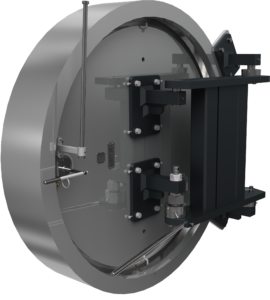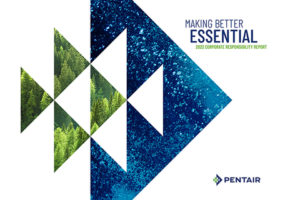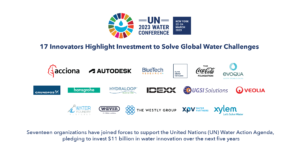Waste Technologies Transform Problems to Profit
Anaerobic digestion processes that radically improve the quality of waste water while delivering green energy extracted from biological waste streams are emerging as a profitable way for agricultural and food processing industries cope with the twin impact of drought and pollution challenges.

Many regions are increasingly affected by drought and climate change, including large areas of the USA (Image: Global Water Engineering)
High-temperature thermophilic anaerobic digestion technologies, typically operating at 55 deg C, are part of a combination of processes that digest waste water’s organic content to produce green energy (methane) while achieving outstanding waste water effluent discharge qualities.
Post-anaerobic treatment steps can also further increase water quality for extensive recycling, which is also becoming particularly relevant to areas of the US and Canada suffering from chronic drought.
About 25 per cent of contiguous US was covered by drought mid-year, according to the US Drought Monitor News, with California 99 per cent drought-affected and drought generally worsening in the country’s northeast and southeast. Although most regions of Canada have experienced drought, many of the southern regions of the Canadian Prairies and interior British Columbia are most susceptible.
The latest anaerobic technologies from wastewater treatment and waste-to-energy specialist Global Water Engineering are particularly effective for industries such as red meat, poultry, dairy, brewery, canning, paper and packaging, food processing and agribusiness processing including many of the world’s most important crops, including fruit, cane, grain, maize, yams, sorghum, potatoes, beans and cassava.
Results achieved over hundreds of plants globally have achieved removal of organic waste from discharge water of between 70-99 per cent, with scores of the plants installed by GWE also capturing the organic waste converted to methane and using it to power boilers and electricity generators. The further treatment steps for recycling of water after anaerobic processing can also result in up to 75 percent of the treated water being available for re-use, says GWE’s technology supplier in the US and Canada, Global Water and Energy (GW&E).
“For the many locations in the US and Canada that are suffering from prolonged drought, wastewater reuse/recycling is an excellent way to conserve a precious resource. In fact the water recovery aspect can even be more valuable than the energy in some cases here,” says Ian Page, Vice President of GW&E.
“GW&E/GWE can provide complete processes for adding on to the anaerobic digester, in order to polish the anaerobic effluent to reuse quality. These may include one or more processes for further organics removal, nutrient removal, or other treatment, and can be designed to meet essentially any quality required. We have a great deal of experience providing reuse systems, for such use as irrigation, toilet flushing, aquifer recharge, and many other uses.”
GWE’s latest success in a drought-prone area was by the leading Japanese meat processor NH Foods at Oakey Beef Exports in Australia, where CST Wastewater Solutions employed Global Water Engineering anaerobic digestion technology to convert organic waste in from discharge water into green energy (methane) representing 40 per cent of the plant’s natural gas needs. The cost of construction is expected to be repaid inside five years, then add profitability to the bottom line in perpetuity, says Oakey Beef Exports General Manager Mr Pat Gleeson.
Oakey’s Cohral plant – the first GWE Covered High Rate Anaerobic Lagoon in the world – will produce 183.3 gigajoules of energy a day when it reaches design capacity through the combustion of methane produced, says the Managing Director of CST Wastewater Solutions, Mr Michael Bambridge, whose company represents GWE technologies in Australia. GWE, with headquarters in Thailand, is headed by green Global Water Engineering CEO and Chairman Mr Jean Pierre Ombregt, who has been a world leader in anaerobic digestion of industrial effluents and green energy solutions for more than 35 years and whose company has been involved in more than 300 water and waste water projects in Asia, Africa, North and South America, Australia, China, Europe (including Eastern Europe) and Russia.
Many of these projects have attained outstanding waste water processing efficiencies of up to and exceeding 99 per cent organic load removal by further steps in the anaerobic process. Good solutions do not have to be extortionately expensive for the wide variety of industries that can employ them. Such industries include red meat, poultry, dairy, brewery, canning, paper and packaging, food processing and agribusiness processing including many of the world’s most important crops, including fruit, cane, grain, maize, yams, sorghum, potatoes, beans and cassava.
- An excellent first step in many instances can be taken by covering and lining lagoons and incorporating anaerobic processes with properly engineered feed and recycle systems, such as those in the Cohral process.
- A second progressive option can involve the use of tanks to containing anaerobic and other processes, minimising land use, reducing plant footprints and providing high security against leaks and groundwater contamination. Anaerobic processes can also be more closely efficiently controlled in such close environments, optimising water purification and green energy production.
- A third optimum stage can be the eventual incorporation of the most advanced anaerobic technologies into sealed tank environments, such as GWE’s Raptor treatment system for organic residues, for example, which can convert almost any organic residue or energy crop into biogas, valuable electricity or heat.
The efficiency and versatility of the Raptor process was demonstrated recently by a ground-breaking GWE installation which won GWE a major international chemical engineering award from the Institute of Chemical Engineers (IChemE), which represents more than 40,000 chemical engineers worldwide. This latest, 2014, Energy Award involved a world first with Chok Chai Starch in Thailand, where a GWE Raptor system is used to convert wet pulp waste product from the processing of cassava roots into biogas.
The technology installed at Chok Chai Starch helps the factory achieve a minimum of 80 per cent conversion of the organics present in the pulp to biogas (methane), treating a maximum of 370 tons a day of wet pulp containing 68,700kg a day COD (chemical oxygen demand).
Daily biogas production exceeds 30,000 Nm3 at 60 per cent CH4 content. The Chok Chai Starch RAPTOR™ starch plant produces enough biogas to generate 3.3-3.4 MW of renewable electricity for sale to the local grid, while the biogas produced by previously installed ANUBIX™ B reactors is heating the factory’s two thermal oil boilers using green energy produced from digestion of organic matter in its waste water.
Anaerobic digestion facilities have been recognised by the United Nations Development programme as one of the most useful decentralised sources of energy supply, as they are less capital-intensive than large power plants. They can also benefit local communities by providing local energy supplies and eliminate the need for large and often smelly and environmentally challenging settling lagoons.
Anaerobic technology is particularly applicable to countries suffering drought, where treated waste water not only provides green energy to substitute for fossil fuels emitting climate change gases, but also processes waste streams to high recycling standards.
Thermophilic anaerobic/anaerobic systems have been proven internationally on slaughterhouse wastes, including digestion of wastes such as manure, stomach contents, blood and excess biosludge, which are transformed into biogas (methane), fertilizer and environmentally outstanding waste water effluent.
“The quantities of methane produced by anaerobic digestion can diminish or even completely replace the use of fossil fuels in the production process,” says Mike Bambridge.
One ton of COD (chemical oxygen demand) digested anaerobically generates 350Nm3 of methane, equivalent to approximately 312 litres of fuel oil, or generates about 1,400 kWh of green electricity. Multiplied over a plant over a year, this output can and does add up to millions of dollars saved on fossil fuels, says Mr Bambridge.
Profit in perpetuity
Depending of the scale of the anaerobic plant employed, the green energy generated can repay the cost of the anaerobic plant within as little as two years – and go on generating profit virtually in perpetuity.
GWE Chairman and CEO Mr Jean Pierre Ombregt says advanced anaerobic technology is strongly applicable to any factory or process with one or more digestible solid waste streams.
“Green energy alternatives such as wind power and solar power get most of the headlines for their achievements, but anaerobic processes are even more suited to industry in many instances, given that it provides reliable base load power and simultaneously treats wastewater to high discharge standards.
“Biogas from waste water is an outstanding source of base load power. As part of a renewable energy mix – complementing wind and solar generation, for example – electricity generated with biogas is highly reliable and consistent. As the major component of natural gas, methane is an environmentally attractive alternative to fossil fuels.”
Source: GLOBAL WATER & ENERGY







